(Cross-posted from Daily Kos)
While most of the political attention these days is aimed at Pennsylvania’s April 22nd primary, perhaps the more important date is May 6th – when both Indiana and North Carolina hold their primaries. With a combined 187 pledged delegates at stake, it is the day that has the most pledged delegates remaining. After those two states (along with Guam, on May 3rd) have voted, 61.7% (349) of the remaining 566 pledged delegates will have been allocated. With North Carolina shaping up to be a blowout for Barack Obama, most of the attention is being focused on Indiana, which is shaping up to be a swing state in the primary.
The most recent polls show Hillary Clinton with a lead in the single digits – which is my starting point for my analysis of the state. Please find my district-by-district prediction for Indiana below the fold…
Indiana (May 6th primary, 72 pledged delegates)
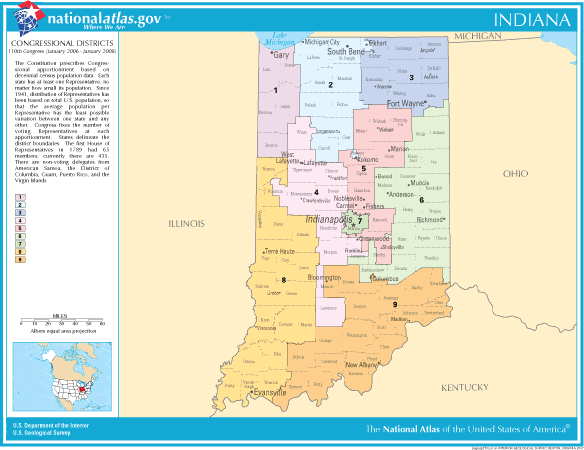
Indiana has been called a ‘swing state’ in the primary (not in the general election, where it doesn’t seem clear that Indiana would be in play unless Evan Bayh had a spot on the ticket). It’s a next-door neighbor to Obama’s home state of Illinois; to date, he has won every state that borders Illinois. However, Indiana’s demographics are much closer to those of Ohio, and it lacks the large urban sprawl of a city like Chicago. While Northwestern Indiana may be fertile ground for Obama due to the district’s proximity to Chicago, the rest of the state (with the exception of Indianapolis, located squarely in the 7th Congressional District) looks to be favorable towards Clinton. She also boasts the endorsement of the most important Democrat in the state, Sen. Evan Bayh. Obama did win the recent endorsement of former Rep. Lee Hamilton, a widely-respected figure who represented South Indiana in the House for 34 years.
Obama has paid a couple of visits to the state (visiting Plainfield, a suburb of Indianapolis, and Fort Wayne), while Clinton has been in the state a bit more. Additionally, Bill Clinton has done several events in-state, likely meaning that the Clinton campaign has a head start on the retail politicking. That being said, the Obama campaign has used their money edge to open more offices and blanket the airwaves first. Will it be enough to overcome the built-in advantages the state offers Clinton? Who knows…according to the most recent SurveyUSA poll, Clinton leads in every region except for Indianapolis. She definitely starts out with an edge, and it will be up to the Obama campaign to fight for the win here.
IN CD-01: 6 delegates
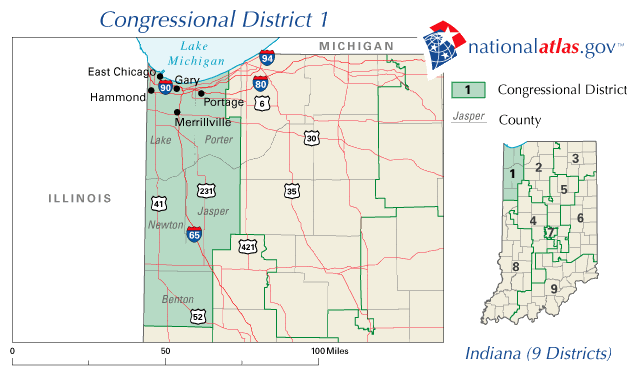
Outside of the Indianapolis area, this seems to be the district where Obama will have the best performance. Given that the northwestern area of the district is essentially considered a suburb of Chicago (just take a look at East Chicago) and a generally urban bent, along with a reasonably-sized African-American population (18.3% of the population), it looks to be favorable. Gary, though, is an aging industrial city that has the kind of white blue-collar workers that have favored Clinton to date. While the counties that border this district in Illinois would likely give the senator the 58.5% needed to take a 4-2 split, I don’t believe he will perform as well, thus earning a 3-3 split in the delegates.
Allocation of CD-01 delegates
Hillary Clinton: 3 pledged delegates
Barack Obama: 3 pledged delegates
IN CD-02: 6 delegates

The 2nd district is represented by Blue Dog Joe Donnelly, who ousted Chris ‘Count’ Chocula in the 2006 midterm elections by a healthy 8% margin. The district is mostly urban, centered in South Bend. Given the results from Michigan’s discounted January 15th primary, it seems that Clinton will be able to earn the 58.5% needed for a favorable 4-2 delegate split easily. The demographics largely favor her as well; the district has a lower-middle income population that is largely white and socially conservative. If Obama spends some time campaigning here, he may be able to move the district more towards an even 3-3 split.
Allocation of CD-02 delegates
Hillary Clinton: 4 pledged delegates
Barack Obama: 2 pledged delegates
IN CD-03: 4 delegates

This district is even ‘whiter’, so to speak, than its companion district to its west. The median income is around the Indiana state average, meaning it is likely favorable to Clinton. Obama has paid a visit to Fort Wayne, one of the district’s main population centers. Based on the counties in Western Ohio bordering the district, it looks like Clinton will probably score between 55-60% of the vote – a clear majority, but not anywhere close enough to the 62.5% needed to earn the 3-1 split.
Allocation of CD-03 delegates
Hillary Clinton: 2 pledged delegates
Barack Obama: 2 pledged delegates
IN CD-04: 4 delegates

This district stretches from the northwestern portion of the state to parts of southern Indiana, including the western portion of the Indiana suburbs. While the demographics favor Clinton, it’s unlikely that she will be able to break the 62.5% threshold. Obama’s first event in Indiana was in Plainfield, located in the eastern portion of the district.
Allocation of CD-04 delegates
Hillary Clinton: 2 pledged delegates
Barack Obama: 2 pledged delegates
IN CD-05: 4 delegates
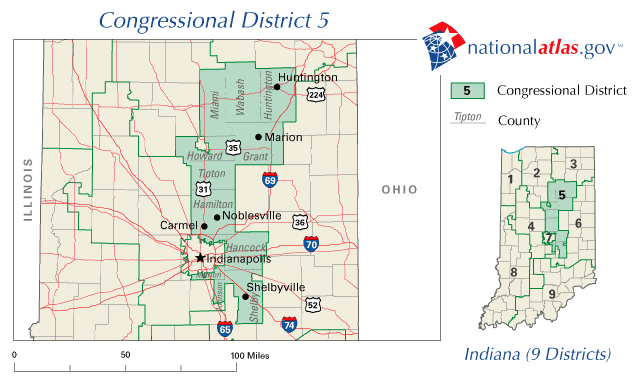
Basically a mirror image of the 4th Congressional district, CD-05 is predominantly white (94.1%) but is also a district where the median income outpaces the statewide average. It’s a very Republican district – it gave 71% of its vote to Bush in 2004 – and is represented by the odious Rep. Dan Burton. While an upscale white district typically tends to favor Obama, this district is also extremely conservative and may have a good deal of the ‘Limbaugh Democrats’. I don’t think either candidate has a particularly good shot of reaching 62.5% for a 3-1 split here.
Allocation of CD-05 delegates
Hillary Clinton: 2 pledged delegates
Barack Obama: 2 pledged delegates
IN CD-06: 5 delegates
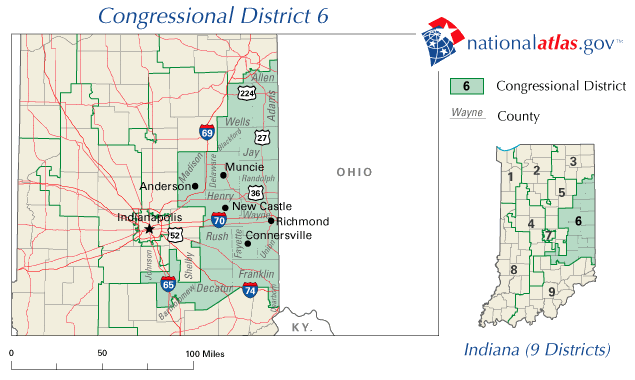
Based on the results from Ohio, it won’t be in doubt that Clinton will get the majority of delegates from this district. That being said, she didn’t come close to breaking the 70% barrier in the bordering counties that would be required to net a 4-1 split from the district. It’s home to longtime blogger and congressional candidate Barry Walsh, who may be able to provide some more insight into the district. That being said, I think it’s a safe bet to predict a 3-2 delegate split in favor of Clinton.
Allocation of CD-06 delegates
Hillary Clinton: 3 pledged delegates
Barack Obama: 2 pledged delegates
IN CD-07: 6 delegates
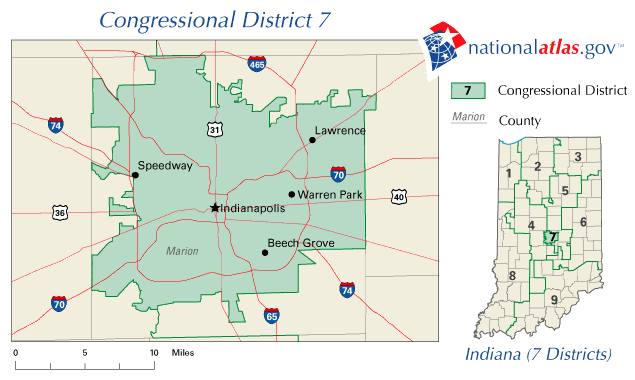
Indianapolis is where Obama is favored, according to the aforementioned SUSA poll. It’s also the only district outside of CD-01 that has a sizable African-American population in Indiana (29.4% of the population). While urbanized areas have typically favored Obama, Indianapolis may not be as favorable as other areas. Newly-elected Rep. Andre Carson only won his race over Republican Jon Elrod by 11 percent, suggesting that Obama likely won’t win by an overwhelming margin. He should be able to get over the 58.5% threshold with relative ease to pick up the 4-2 split, though.
Allocation of CD-07 delegates
Barack Obama: 4 pledged delegates
Hillary Clinton: 2 pledged delegates
IN CD-08: 6 delegates
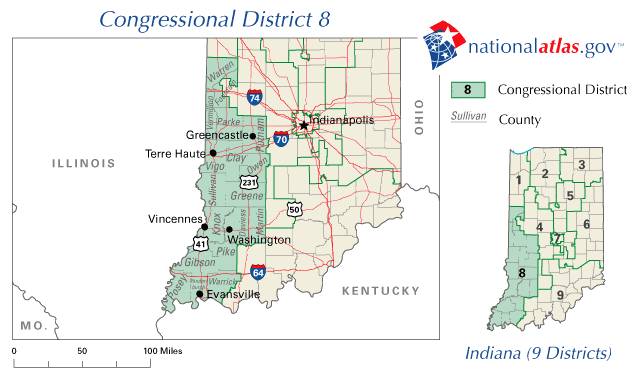
This is the second of 3 districts picked up by House Democrats in 2006 (the other being CD-09); currently, it is represented by the fairly conservative Brad Ellsworth. The district is the largest in Indiana by geographic area, and it is largely split between urban and rural areas. The portion of the district that borders counties in Eastern Illinois span from going to Obama by healthy double-digit margins to high single-digit victories for Clinton. While the demographics (a white, working-class population with a median income below the state average) would seem to favor Clinton, I don’t believe that she’ll be able to hit the 58.5% needed to win a majority of the delegates. As such, I do think that the delegate split will be 3-3.
Allocation of CD-08 delegates
Hillary Clinton: 3 pledged delegates
Barack Obama: 3 pledged delegates
IN CD-09: 6 delegates
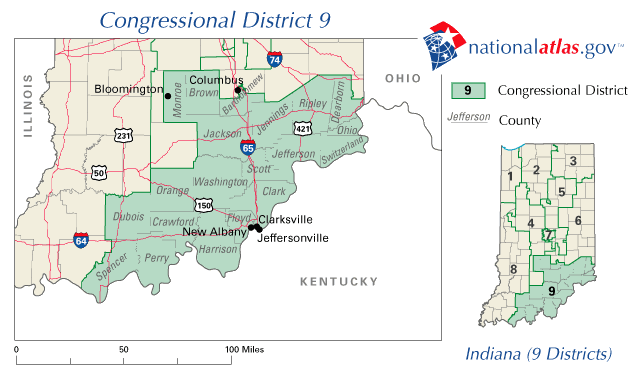
This is the district that Obama backer Lee Hamilton represented for the effectively the latter third of the 20th century. It’s the most rural district in the state and is currently represented by Baron Hill, who won the seat back from Republican Mike Sodrel after 2 years. With a friendly demographic base (rural, 94.8% white, working-class population), along with a long border with Kentucky – a state whose demographics are decidedly unfriendly for Obama – I think that Clinton will be able to pick up the extra delegate and win the district 4-2, despite Hamilton’s backing for Obama.
Allocation of CD-09 delegates
Hillary Clinton: 4 pledged delegates
Barack Obama: 2 pledged delegates
At-Large Delegates (16 delegates) and Pledged PLEO Delegates (9 delegates)
Based on recent polling, it appears that Clinton has a lead somewhere in the high single digits at this point. I suspect that, given the state’s demographics, that’s a fair assumption to make. Although Obama’s leaked spreadsheet projections have Obama winning by 7%, I do believe this will be the first state where they will lose a state they predicted to win. For now, I feel that a Clinton victory over Obama by a margin of 8% (54-46) is relatively accurate. This will result in Clinton netting 3 delegates from the statewide allocation – half of her total margin.
Allocation of at-large delegates
Hillary Clinton: 9 pledged delegates
Barack Obama: 7 pledged delegatesAllocation of pledged PLEO delegates
Hillary Clinton: 5 pledged delegates
Barack Obama: 4 pledged delegates
Conclusion
As of now, my current prediction is that Hillary Clinton will come away from Indiana with 39 pledged delegates, compared to Obama’s 33 pledged delegates. This will further cut into Obama’s pledged delegate lead but is likely to be more than negated from his likely victory in North Carolina (which I will chronicle next). Given the state’s preponderance of 4- and 6-delegate districts, it’s going to be difficult to see delegate movement in many of the state’s congressional districts. However, there is room to improve – and to worsen – for Obama.
Best-case scenario for Obama
Due to the ‘neighboring state’ status of Indiana, I do think it is possible for Obama to pull off a popular vote victory in Indiana; however, I see his campaign’s projection of a 7% margin (53-46) as something of a ceiling for how high he would win by. This would result in a +2 advantage from the statewide allocation (instead of my predicted – 3). He could also outperform in CD-01, giving him a 4-2 delegate split, and he could hold down the margins in CD-02 and CD-09 to a 3-3 split. This would result in a 38-34 advantage for Obama. The more important victory to take away would be psychological; given that the importance of a Pennsylvania victory for Clinton has been effectively downplayed, an Obama victory in a ‘true’ battleground state, combined with a North Carolina blowout, would effectively end the Clinton campaign.
Worst-case scenario for Obama
Given that my estimates tend to have an inherently optimistic look at the numbers from Clinton’s perspective, it will be difficult for her to build on the results given above. It’s possible (albeit unlikely) that she holds Obama under 58.5% in CD-07, resulting in a 3-3 split. She may also earn a 4-2 split in CD-08, and it’s possible that, with enough campaigning, she might be able to earn the odd 3-1 delegate split in one of the 4-delegate districts (CD-03, CD-04, or CD-05). There’s also the concern of the effect of ‘Limbaugh Democrats’ in this primary; with a semi-open primary, it’s possible that Republicans in these heavily-Republican districts decide to create mischief by voting in the Democratic primary. That being said, I can’t see Clinton winning by a margin higher than 55-45 – which doesn’t earn her any more delegates at the statewide level. The maximum number of delegates she could net out of the state might be as high as +12, but it doesn’t seem likely that she can eke out that kind of margin unless she wins handily in a place like CD-08, which includes Evan Bayh’s base of Terre Haute.
The battle for Indiana is going to be hard-fought, and it seems that Clinton will be starting out with a clear, if not impenetrable, edge in the state. It’s going to take a lot more attention from Obama, who is now comfortably ahead in North Carolina. Combined with a victory from with North Carolina, a win in Indiana would give the Obama campaign an opportunity to knock out Clinton 2 weeks after Pennsylvania votes (for what it’s worth, Guam has 4 delegates and is likely going to split them 2-2 on their May 3rd caucuses). Unlike Pennsylvania, where the battle to win the state is much more difficult, Indiana is winnable for the Obama campaign. But he’s got to campaign there a little more than he’s been doing.




